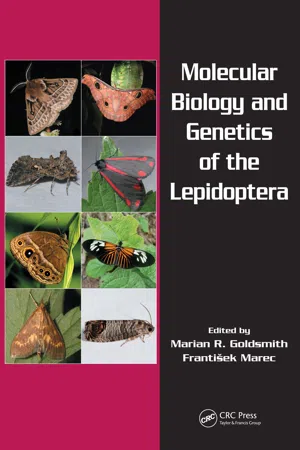
Molecular Biology and Genetics of the Lepidoptera
- 368 pages
- English
- PDF
- Available on iOS & Android
Molecular Biology and Genetics of the Lepidoptera
About this book
Numerous and charismatic, the Lepidoptera is one of the most widely studied groups of invertebrates. Advances in molecular tools and genomic techniques have reduced the need for large sizes and mass-rearing, and lepidopteran model systems are increasingly used to illuminate broad-based experimental questions as well as those peculiar to butterflies. Putting the spotlight on the second most numerous order of insects living today, this book provides a summary of cutting-edge studies of the Lepidoptera as an organism in and of itself and as model systems. Leading researchers discuss symbiosis, genomes, sex determination, natural products, ecophysiology, sensory systems, pest control, the sterile insect technique, immunity, and evolution development. Understanding the biology and genetics of butterflies and moths may lead to new species-selective methods of control, saving billions of dollars in pesticide use and protecting environmental and human health, making the sections on pest control and the sterile insect technique extremely important.
Frequently asked questions
- Essential is ideal for learners and professionals who enjoy exploring a wide range of subjects. Access the Essential Library with 800,000+ trusted titles and best-sellers across business, personal growth, and the humanities. Includes unlimited reading time and Standard Read Aloud voice.
- Complete: Perfect for advanced learners and researchers needing full, unrestricted access. Unlock 1.4M+ books across hundreds of subjects, including academic and specialized titles. The Complete Plan also includes advanced features like Premium Read Aloud and Research Assistant.
Please note we cannot support devices running on iOS 13 and Android 7 or earlier. Learn more about using the app.
Information
Table of contents
- Front cover
- Contents
- Preface
- About the Editors
- Contributors
- Chapter 1. Evolutionary Framework for Lepidoptera Model Systems
- Chapter 2. Recent Progress in Silkworm Genetics and Genomics
- Chapter 3. Rise and Fall of the W Chromosome in Lepidoptera
- Chapter 4. Sex Chromosomes and Sex Determination in Bombyx mori
- Chapter 5. Evolutionary and Developmental Genetics of Butterfly Wing Patterns: Focus on Bicyclus anynana Eyespots
- Chapter 6. Prospects for Locating Adaptive Genes in Lepidopteran Genomes: A Case Study of Butterfly Color Patterns
- Chapter 7. Molecular and Physiological Innovations of Butterfly Eyes
- Chapter 8. Lepidopteran Circadian Clocks: From Molecules to Behavior
- Chapter 9. Lepidopteran Chemoreceptors
- Chapter 10. Sexual Communication in Lepidoptera: A Need for Wedding Genetics, Biochemistry, and Molecular Biology
- Chapter 11. Genetics of Host Range in Lepidoptera
- Chapter 12. Genetics and Molecular Biology of the Major Crop Pest Genus Helicoverpa
- Chapter 13. Molecular Genetics of Insecticide Resistance in Lepidoptera
- Chapter 14. Innate Immune Responses of Manduca sexta
- Chapter 15. Lepidopterans as Model Mini-Hosts for Human Pathogens and as a Resource for Peptide Antibiotics
- Chapter 16. Intrahemocoelic Toxins for Lepidopteran Pest Management
- Chapter 17. The Interactions between Polydnavirus-Carrying Parasitoids and Their Lepidopteran Hosts
- Chapter 18. Densovirus Resistance in Bombyx mori
- Color Insert
- Back cover